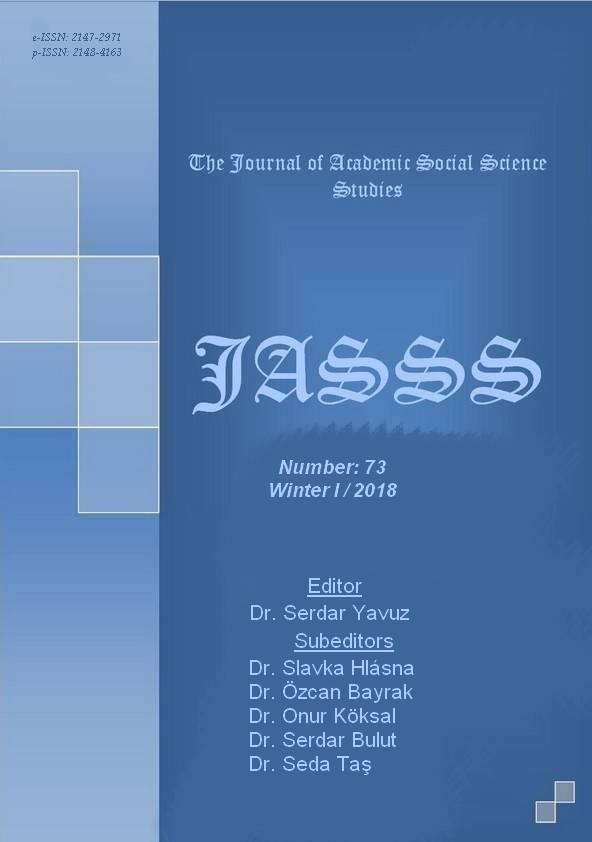Author :
Abstract
Bu araştırma, sınıf öğretmenlerinin çocuğa yönelik cinsel istismar tutumlarının bazı değişkenlere (cinsiyet, yaş, medeni durum, meslekteki kıdem, çocuk ihmal ve istismarı konusunda eğitim alma, eğitim gereksinimi ve cinsel istismarın belirtilerini tanımlamada kendini hazır hissetme) göre incelenmesi amacıyla yapılmıştır. Araştırmada genel tarama modeli türlerinden ilişkisel tarama modeli kullanılmıştır. Çalışma grubunu, 2016-2017 eğitim-öğretim yılında Afyonkarahisar merkez ilçelerinde Milli Eğitim Müdürlüğüne bağlı resmi ilkokullarda görev yapan ve araştırmaya gönüllü katılan 406 sınıf öğretmeni (214 kadın ve 192 erkek) dâhil edilmiştir. Araştırmada veri toplama aracı olarak "Genel Bilgi Formu" ve öğretmenlerin çocuğa yönelik cinsel istismar tutumlarını belirlemek amacıyla Choo, Walsh, Chinna ve Tey (2013) tarafından geliştirilen ve Akın, Aşut, Demirci, Akbaş, Güler, Demir ve Kaymaz (2013) tarafından Türkçeye uyarlanan "Çocuğa Yönelik Cinsel İstismar Tutum Ölçeği" uygulanmıştır. Verilerin analizinde frekans ve yüzde gibi betimsel istatistiklerin yanı sıra normallik sağlanamadığı için Mann-Whitney U Testi ve Kruskal-Wallis H T kullanılmıştır. Kruskal Wallis H Testi’nde istatistiksel olarak anlamlı farklılıkların görülmesi durumunda Post-Hoc Çoklu Karşılaştırma Testi kullanılarak hangi gruplar arasında farklılık olduğu belirlenmiştir. Araştırma sonucunda, sınıf öğretmenlerinin çocuğa yönelik cinsel istismar tutumları ile cinsiyet, yaş ve medeni durum değişkenleri arasında istatistiksel olarak anlamlı bir ilişkinin olduğu belirlenmiş; ancak kıdem, çocuk ihmal ve istismarı konusunda eğitim alma ve eğitim gereksinimi ve cinsel istismarın belirtilerini tanımlamada kendini hazır hissetme değişkenleri arasında istatistiksel olarak anlamlı ilişki bulunamamıştır.
Keywords
Abstract
The aim of this study was to investigate elementary school teachers’ attitudes towards child sexual abuse according to some variables (gender, age, marital status, seniority in the profession, in service training about child neglect and abuse, training needs and self-readiness to identify the symptoms of sexual abuse). Relational screening model was used in the study. The study group consisted of 406 elementary school teachers (214 females and 192 males) who were in charge at public elementary schools in the central districts of Afyonkarahisar in 2016-2017 academic year. As data collection tools, “Demographical Information Form” and in order to determine the teachers’ attitudes towards child sexual abuse “Teacher Reporting Attitudes Scale - TRAS” developed by Choo, Walsh, Chinna and Tey (2013) and adapted into Turkish by Akın, Yıldız, Uysal and Erguvan (2013) were used. In addition to descriptive statistics such as frequency and percentage, Mann-Whitney U Test and Kruskal-Wallis H Test were used for data analysis since the distributions were not normal. In the case of statistically significant differences in the Kruskal Wallis H Test, Post-Hoc Multiple Comparison Test was utilized to find out between which groups there was a difference. As a result of the study, it was found that there was a statistically significant relationship between the teachers’ attitudes towards child sexual abuse and their gender, age and marital status; however, there was no statistically significant relationship between the attitudes and seniority in the profession, in service training about child neglect and abuse together with training needs, self-readiness to identify the symptoms of sexual abuse.





